Restaurants and eateries are beginning to hit the panic button as the coronavirus pandemic continues to eat into their business.
Nearly 90 percent of restaurants under National Restaurant Association of India (NRAI)’s ambit downed shutters after India instituted a nationwide lockdown on March 25, 2020, allowing only essential services to operate.
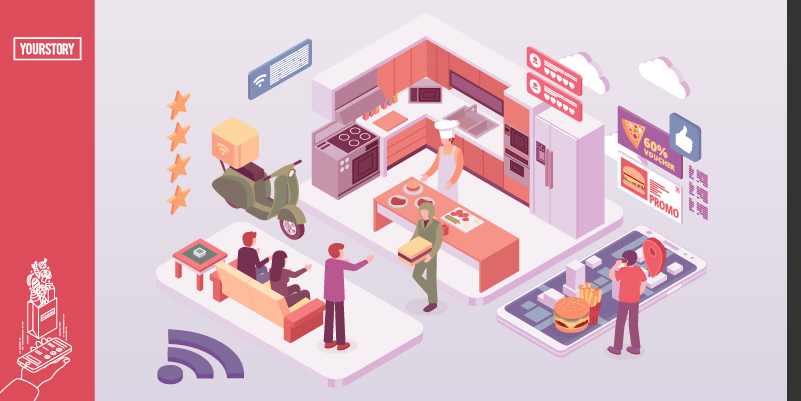
Image Credit: Anubhav
Four months later, restaurants continue to flounder amid rising coronavirus cases and social distancing norms. According to the NRAI, which represents over 500,000 restaurants, over 20 lakh people directly employed in the sector may be rendered jobless.
Keen to stay away from restaurants, diners have shown a propensity for takeaway options, leading to a shift towards cloud kitchens, cooking facilities that cater only to online delivery orders and that have no physical dining space.
RedSeer Management Consulting, in a recent report, said cloud kitchens were set to become a $2 billion industry in India by 2024, up from $400 million in 2019. In fact, it called cloud kitchens the “secret sauce to survive in the post-COVID restaurant market.”
RedSeer research revealed that as of mid-June, India’s overall $65 billion foodservice market was working only at 10 percent of its size. Of this, food delivery comprises 40 percent.
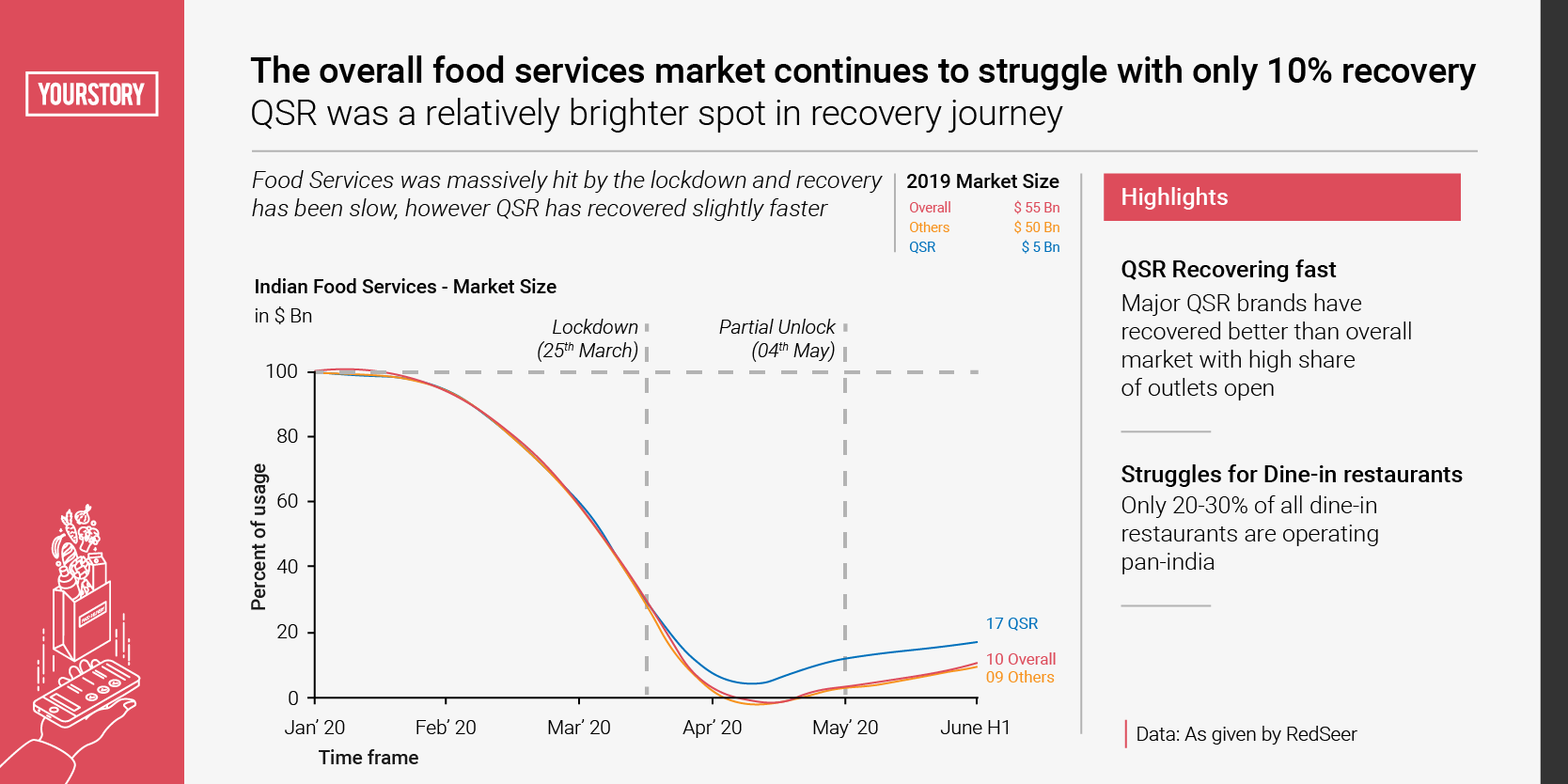
Image Credit: Anubhav
Data Source: RedSeer
Delivery to recover faster than dine-in
A CRISIL report said with restaurant footfall “at an all-time low and sales down as much as 90 percent,” takeaway was a vital source of revenue for many restaurants.
Arpita Aditi, Co-founder of the B2B foodtech startup NutnBolt, said the restaurant business had been significantly impacted by COVID, with several restaurants shutting shop permanently and hundreds of people laid off.
“Now, if you look at the business, the dine-in segment contributed 70 percent, while delivery comprised 30 percent. This 70 percent has vanished, and it is vital for restaurants to find ways to get that revenue. This will happen through delivery in the current scenario,” she said.
RedSeer research revealed that the number of orders was marginally increasing and was up by 40 to 60 percent of the original numbers. The online food delivery segment may take until December 2020 to recover by 100 percent, in an accelerated case scenario. The research added that in the normal scenario, the recovery may reach 200 percent by the next IPL season.
“Online food delivery has been growing at 100 to 150 percent for the last four years, and COVID has significantly impacted it. But delivery will recover faster than dine-in simply due to the reduced touchpoints. Dine-in will take longer than April to May 2021,” said Rohan Agarwal, Director, RedSeer.
Meanwhile, CRISIL estimated that the recovery of the restaurant sector would take at least a year after the lockdown was lifted.
In an earnings review report, Gurugram-based foodtech unicorn Zomato had said its FY20 India food delivery GMV grew by 108 percent over FY19. When COVID-19 cases started spreading in March, Zomato’s food delivery business GMV was down by 80 percent as compared to its peak in February.
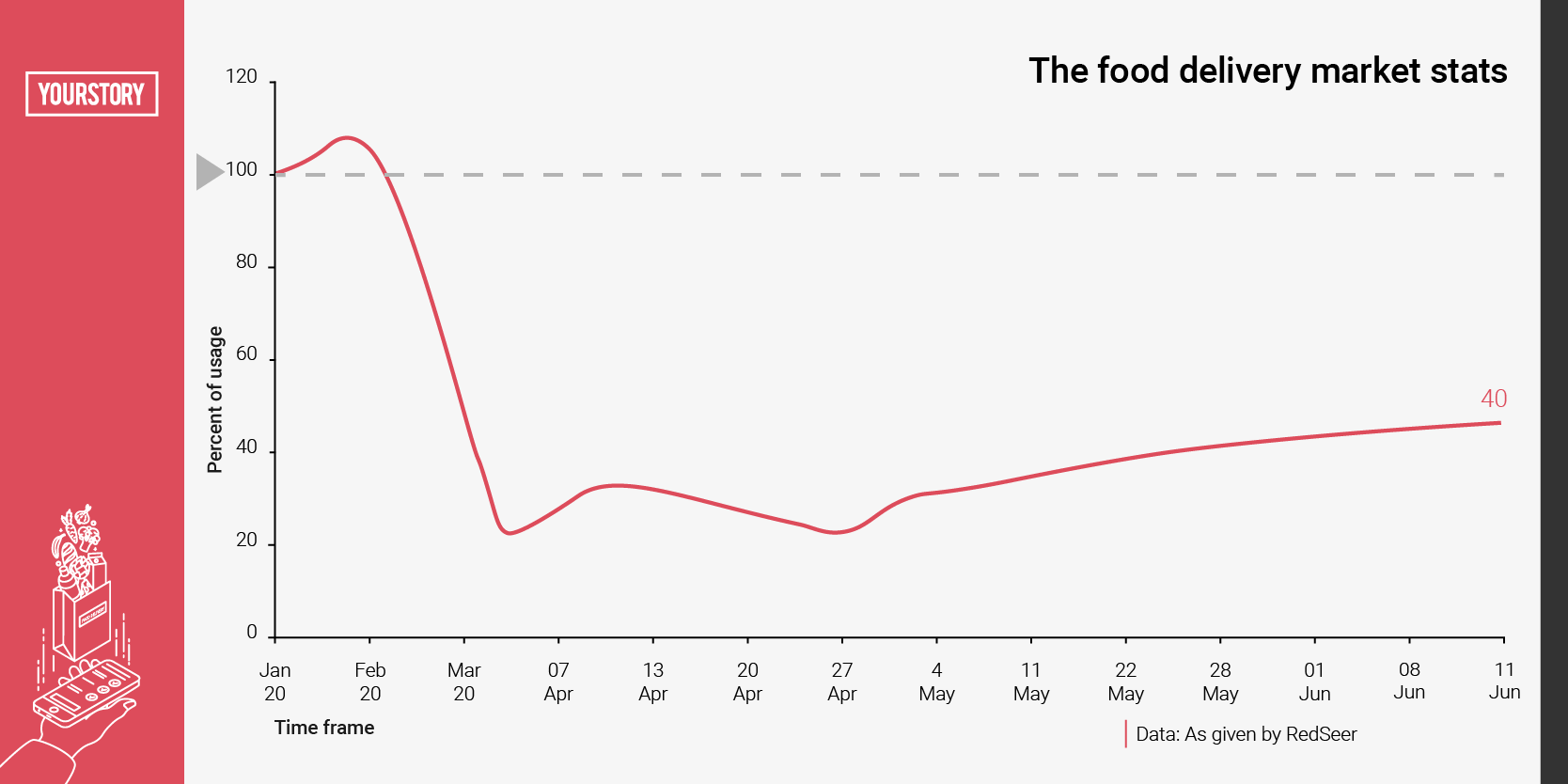
Image Credit: Anubhav
Data source: RedSeer
Deepinder Goyal, Co-founder and CEO, Zomato, in the report said the foodtech unicorn expected sharp recovery in order volumes as lockdowns continued to ease and the operating environment continued to improve.
He said the unit economics of the food delivery business had improved consistently over the last 18 months. In Q1 FY20, Zomato used to make a negative contribution margin of Rs 47 per order; in Q1 FY21, it made a positive contribution margin of Rs 27 per order.
Cloud kitchens help reduce operational costs
Reports suggest that for every 100 restaurants that open across the world, only one survives after two years in the business. Operational cost is the main reason. There are three areas that cause bleeding of capital for a restaurant: infrastructure, licences, and working capital.
This held true even in a pre-COVID world. “It practically is impossible to run a restaurant without the day-to-day operational costs being met, as the margins are very low,” Rohan said.
Apart from being a better fit in the time of social distancing, cloud kitchens have gained in popularity as they help minimise costs, especially those of rent and wait staff. The market opportunity is high, investment is low, and the model offers ease in experimentation and scaling.
Gurmeet Kochhar, an ex-investment banker and founder of two successful cloud kitchens, said, “The working capital and infrastructure expenses needed for day-to-day operations makes running a restaurant an expensive proposition.”
How does a traditional restaurant stack up against a cloud kitchen? A basic 50-seater restaurant in an above-average area will cost you anywhere between Rs 50 lakh and Rs 1 crore. Putting liquor on the menu will set you back by an additional Rs 50 lakh to Rs 1 crore.
On the other hand, a cloud kitchen can be set up at almost half that cost: between Rs 20 and 25 lakh. The total cost for running a restaurant is at an average of Rs 1.36 crore per month as compared with a cloud kitchen that costs approximately Rs 50 lakh per month.
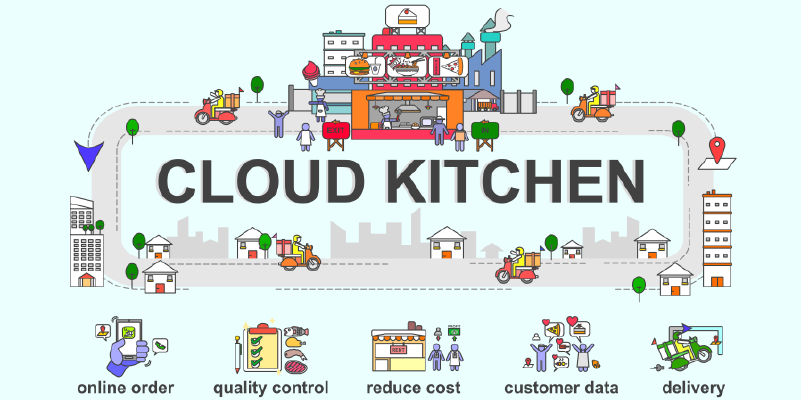
Image Credit: Shutterstock
Vishal Bhatia, New Supply Business, Swiggy, in an earlier conversation with YourStory, said: “Just in the past two years, delivery-only models have grown 10x.”
The coronavirus pandemic may have slowed most sectors worldwide, but it seems to have propelled the cloud kitchen model.
Kalol Banerjee, Co-founder of Rebel Foods, said cloud kitchens meant different things to different people. “The concept essentially translates into a huge kitchen that you let out to restaurants. Our model is not to look at cooking stations by brands, but by processes. It’s common knowledge that there is no real estate cost to cloud kitchens, but we pay commissions to aggregators for deliveries.”
Rebel Foods claims to be India's largest cloud kitchen chain and operates Faaso’s, Oven Story, Firangi Bake, and Behrouz. It has over 1,500+ restaurants serving across 16 cities via online food delivery.
The low overheads make the cloud kitchen model highly profitable. However, it necessitates high order volumes to reach profitability.
Kalol said: “There were no brands when we started in India. Compare this to the US, with over 600 chains. We realised that if you can make food consistently and safely across kitchens…that is the play for scale.”
He added that most big hotels want to give them their kitchens as they are empty through the day. Rebel Foods has developed an operating system to build digital brands that they can “scale up and down as and when needed”, and Kalol believes social distancing will make brands like the delivery-only format more popular.
Restaurants will need to consider factors like capping the order value for delivery to look at a significant rise in order volumes.
Aprita says balance is difficult to achieve and restaurants will need to “relook at all their spends and make delivery a significant aspect of their business”.
Vishal Jindal, Co-founder of BiryaniByKilo agrees. “We do not have a high rental cost impacting our business. With smartphones, cloud kitchens like ours are creating brands out of our product. We have scaled up fast and orders are going up amid COVID-19. The restaurant industry has changed, and people will now want to experience good food at home.”
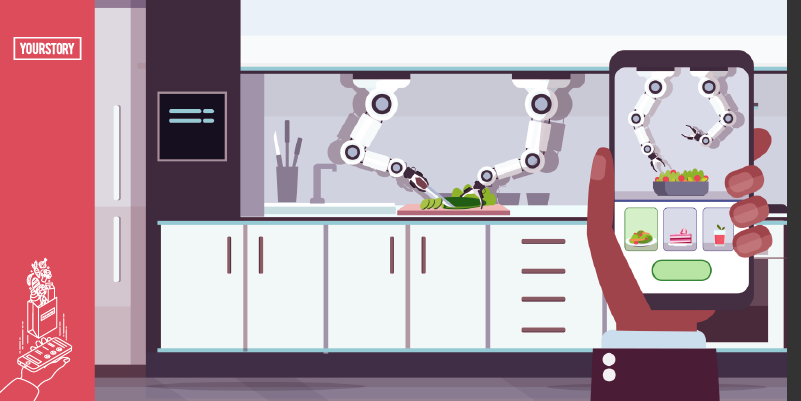
Image Credit: Anubhav
Focussing on the home dining experience
Coronavirus has completely changed the way people approached eating out. Now, it’s common to pre-select the seating, see huge bottles of sanitisers on tables, give orders to servers wearing PPE kits, and ask for UV-sanitised utensils.
Yash, Co-founder of Delhi-based food startup Garniche, said: "As Indians moving towards quality and hygiene, the organised food sector will see tremendous growth. Transparency between the place where food is cooked and where it is consumed will play a huge role in any brand’s growth.”
Amid COVID-19, consumer and managerial behaviour are likely to use AI technology as people seek experiences with fewer human interactions. This will lead to tracking the movement of staff in restaurants and the rise of in-home dining experiences.
With people staying away from restaurants, many brands are working with Delhi-based startup Garniche that sends its chefs home to rustle up meals. All an individual has to do is share details of the kind of cuisine they like, and a home chef appears on your doorstep with the necessary ingredients.
Garniche isn’t the only one tapping the dining-in experience.
Anshumala, Co-founder of Conosh, a platform that supports home chefs, believes the future of food is not in restaurants but in “experiences at home”. Whether you want a Kashmiri dinner or are keen to sample the flavours of Sindh, Conosh’s home chefs promise to cook them for you.
The platform promotes the idea of eating with families, and hosts pop-ups that aim to help people share stories over food. “This is the future because people will not go to public places for a couple of years or at least until there is a vaccine,” Anshumala says.
The basic difference between restaurants and home dining lies in curation.
Anshumala says home chefs put in a lot of time and efforts to dish out something interesting every time. “There is an audience looking out for something new, authentic, and personalised. Marry the two, and we've the perfect demand-and-supply model for organised peer-to-peer exchange.”
Going ahead, experts are unanimous that recovery will be slow for the food services business.
Rohan, of RedSeer, said there has been a 10 percent increase in the overall food services business since the opening of the lockdown, with QSR restaurants seeing a spike.
“The food services business will be one of the last segments to recover. Inherent consumer behaviour has changed, and hygienic and healthy food has become the main requirement,” Rohan said.
(Edited by Teja Lele)
Want to make your startup journey smooth? YS Education brings a comprehensive Funding Course, where you also get a chance to pitch your business plan to top investors. Click here to know more.
Link : https://yourstory.com/2020/07/cloud-kitchens-foodtech-covid19-eats-restaurant-business-zomato
Author :- Sindhu Kashyaap ( )
July 30, 2020 at 05:25AM
YourStory




